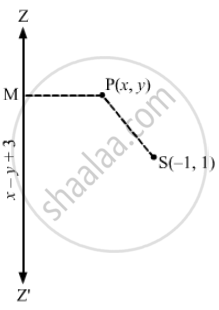Advertisements
Advertisements
प्रश्न
Find the equation of the ellipse in the case:
The ellipse passes through (1, 4) and (−6, 1).
उत्तर
\[ \text{ The ellipse passes through} \left( 1,4 \right)\text{ and} \left( - 6, 1 \right).\]
\[\frac{x^2}{a^2} + \frac{y^2}{b^2} = 1\]
\[ \Rightarrow \frac{1}{a^2} + \frac{16}{b^2} = 1\]
\[\text{ Let} \frac{1}{a^2} = \alpha \text{ and } \frac{1}{b^2} = \beta\]
\[\text{ Then } \alpha + 16\beta = 1 . . (1)\]
\[\text{ It also passes through } \left( - 6, 1 \right).\]
\[\frac{x^2}{a^2} + \frac{y^2}{b^2} = 1\]
\[ \Rightarrow \frac{36}{a^2} + \frac{1}{b^2} = 1\]
\[ \Rightarrow 36\alpha + \beta = 1 . . . (2)\]
\[\text{ Solving eqs. (1) and (2), we get } :\]
\[\alpha = \frac{3}{115} \text{ and } \beta = \frac{7}{115}\]
\[\text{ Substituting the values, we get } :\]
\[\frac{3 x^2}{115} + \frac{7 y^2}{115} = 1\]
\[ \Rightarrow \frac{3 x^2 + 7 y^2}{115} = 1\]
\[ \Rightarrow 3 x^2 + 7 y^2 = 115\]
\[\text{ This is the required equation of ellipse } .\]
APPEARS IN
संबंधित प्रश्न
Find the equation for the ellipse that satisfies the given condition:
Vertices (±5, 0), foci (±4, 0)
Find the equation for the ellipse that satisfies the given conditions:
Vertices (0, ±13), foci (0, ±5)
Find the equation for the ellipse that satisfies the given conditions:
Vertices (±6, 0), foci (±4, 0)
Find the equation for the ellipse that satisfies the given conditions:
Ends of major axis (±3, 0), ends of minor axis (0, ±2)
Find the equation for the ellipse that satisfies the given conditions:
Length of major axis 26, foci (±5, 0)
Find the equation for the ellipse that satisfies the given conditions:
Length of minor axis 16, foci (0, ±6)
Find the equation for the ellipse that satisfies the given conditions:
Foci (±3, 0), a = 4
Find the equation for the ellipse that satisfies the given conditions:
b = 3, c = 4, centre at the origin; foci on the x axis.
Find the equation for the ellipse that satisfies the given conditions:
Centre at (0, 0), major axis on the y-axis and passes through the points (3, 2) and (1, 6)
Find the equation for the ellipse that satisfies the given conditions:
Major axis on the x-axis and passes through the points (4, 3) and (6, 2).
A man running a racecourse notes that the sum of the distances from the two flag posts form him is always 10 m and the distance between the flag posts is 8 m. find the equation of the posts traced by the man.
Find the equation of the ellipse in the case:
focus is (0, 1), directrix is x + y = 0 and e = \[\frac{1}{2}\] .
Find the equation of the ellipse in the case:
focus is (−1, 1), directrix is x − y + 3 = 0 and e = \[\frac{1}{2}\]
Find the equation of the ellipse in the case:
focus is (−2, 3), directrix is 2x + 3y + 4 = 0 and e = \[\frac{4}{5}\]
Find the equation of the ellipse in the case:
focus is (1, 2), directrix is 3x + 4y − 5 = 0 and e = \[\frac{1}{2}\]

Find the equation to the ellipse (referred to its axes as the axes of x and y respectively) which passes through the point (−3, 1) and has eccentricity \[\sqrt{\frac{2}{5}}\]
Find the equation of the ellipse in the case:
eccentricity e = \[\frac{1}{2}\] and semi-major axis = 4
Find the equation of the ellipse in the case:
eccentricity e = \[\frac{1}{2}\] and major axis = 12
Find the equation of the ellipse in the case:
Vertices (± 5, 0), foci (± 4, 0)
Find the equation of the ellipse in the case:
Vertices (0, ± 13), foci (0, ± 5)
Find the equation of the ellipse in the following case:
Ends of major axis (0, ±\[\sqrt{5}\] ends of minor axis (± 1, 0)
Find the equation of the ellipse in the following case:
Length of major axis 26, foci (± 5, 0)
Find the equation of the ellipse in the following case:
Foci (± 3, 0), a = 4
If P is a point on the ellipse `x^2/16 + y^2/25` = 1 whose foci are S and S′, then PS + PS′ = 8.
The line 2x + 3y = 12 touches the ellipse `x^2/9 + y^2/4` = 2 at the point (3, 2).
An ellipse is described by using an endless string which is passed over two pins. If the axes are 6 cm and 4 cm, the length of the string and distance between the pins are ______.
The equation of the ellipse having foci (0, 1), (0, –1) and minor axis of length 1 is ______.
